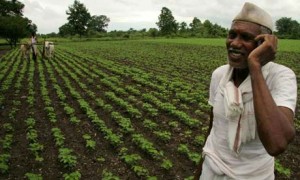According to the U.N. Population Division, over 70 percent of Indians live in rural areas and over half of all Indians are farmers. Yet access to technology and information in many areas is limited, meaning farmers are often left uninformed and at the mercy of erratic weather and disease and pest outbreaks. And even in good growing conditions, farmers may not have access to price information that could help them negotiate with buyers or decide which markets to bring their products to.

While computers and the internet have been slow to reach Indian villages, mobile phones are becoming increasingly common in even the most remote locations as Indian mobile networks expand. According to the Telecom Regulatory Authority of India, over 18 million subscriptions were added in August 2010 alone, bringing the total number of subscriptions to roughly 670 million. Over 50 percent of the population in India has access to a mobile phone.
Many mobile phone makers, including big hitters like Nokia and Sony and smaller Indian companies like Micromax and Maxx Mobile, have kept devices basic and affordable and payment plans are often pay-as-you-go, making mobile phones accessible to people of nearly all income levels.
Instead of “apps” and internet access, mobile service providers in India have developed a remarkable variety of text-based programs that allow Indians to do everything from banking to listening to music on even the most basic phones. People in India use their phones for dozens of functions. As New York Times Columnist Anand Giridharadas put it in an interview on NPR, “It’s this kind of all-in-one magical device that serves a larger-than-life role that almost no single piece of technology serves in the West.”
Given their importance, utility, and growing ubiquity, mobile phones have the potential to be an incredible tool for Indian farmers. In a recent report by the Indian Council for Research on International Economic Relations (ICRIER) the authors identified farmers’ lack of information as a key problem to India’s declining agricultural productivity, continuing on to say that mobile technology, “presents an opportunity to make useful information more widely available.”
For farmers, major companies like Tata Group, Thomson Reuters Group, and Nokia have set up subscription services for farmers that send farmers daily updates via SMS on weather and crop prices. Similar voice-based programs leave daily, automated voicemails. These services station agents at various agricultural markets, monitor weather, and work with local agricultural marketing boards to gather data that can be tailored to address each farmer’s needs. Armed with this previously unavailable information, farmers are able to make more informed decisions about when to plant and where to sell their goods.
Other services, like the Indian Institute of Technology’s aAQUA (“almost All Questions Answered”), allow farmers to text in questions about a how to deal with a certain pest or properly fertilize a crop, andKheti, a system operated by Sheffield Hallam University in England, even allows farmers to send in pictures of problems taken on camera phone.
Competition among service providers has led to a proliferation of such services that are increasingly tailored to the individual subscriber’s needs. Weather information is surprisingly specific, and farmers can choose what crops they want to learn the prices of and in which of India’s dozens of languages they will receive the message.
Plus, prices for these services have remained relatively low, the most expensive coming out is about 800 rupees (about $20 USD) per year—a small price to pay considering many farmers claim such services have helped them avoid dramatic losses and increase profits by several thousand rupees a year
As one farmer said in a recent piece on India Together, “I am sticking with it since it’s giving me dividends.”
To read more about other innovations that utilize mobile phones to provide farmers with useful information, see: A Sustainable Calling Plan and From Phones to Fields.

Danielle Nierenberg, an expert on livestock and sustainability, currently serves as Project Director of State of World 2011 for the Worldwatch Institute, a Washington, DC-based environmental think tank. Her knowledge of factory farming and its global spread and sustainable agriculture has been cited widely in the New York Times Magazine, the International Herald Tribune, the Washington Post, and
other publications.
Danielle worked for two years as a Peace Corps volunteer in the Dominican Republic. She is currently traveling across Africa looking at innovations that are working to alleviate hunger and poverty and blogging everyday at Worldwatch Institute’s Nourishing the Planet. She has a regular column with the Mail & Guardian, the Kansas City Star, and the Huffington Post and her writing was been featured in newspapers across Africa including the Cape Town Argus, the Zambia Daily Mail, Coast Week (Kenya), and other African publications. She holds an M.S. in agriculture, food, and environment from Tufts University and a B.A. in environmental policy from Monmouth College.








